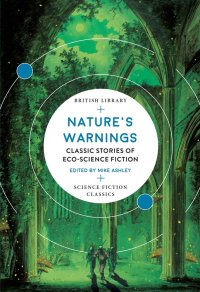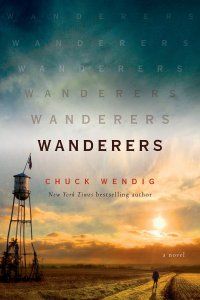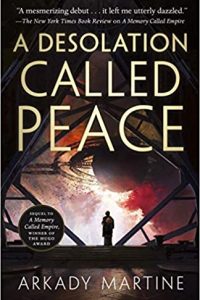Paul Di Filippo Reviews Mike Ashley’s Nature’s Warnings: Classic Stories of Eco-Science Fiction
 Nature’s Warnings: Classic Stories of Eco-Science Fiction, edited by Mike Ashley (British Library Publishing 978-0712353571, trade paperback, 320pp, $16.95) November 2021.
Nature’s Warnings: Classic Stories of Eco-Science Fiction, edited by Mike Ashley (British Library Publishing 978-0712353571, trade paperback, 320pp, $16.95) November 2021.
Being an anthologist is much like being a party host. If you have excellent taste in people (or stories) and know a lot of interesting people (or stories) and can instinctively or cleverly create harmonious or synergistic or even antagonistic assemblages of people (or stories), you will succeed in making a lively, fun, unforgettable time for all the attendees.
Mike Ashley is the consummate host/anthologist. He has all those skills and more. For not only does he have to know all the available living guests (or recent stories), but he has to know all the deceased guests (or classic stories). It’s as if a hostess had to assemble her guest list not only from Lady Gaga, George Clooney, et al, but also include Cleopatra, George Bernard Shaw, and other past luminaries.
In this particular outing, Ashley is sticking to stories all published before 1962, with one or two exceptions. This pivotal date is tagged to the publication of Rachel Carson’s Silent Spring, which triggered our current level of eco-consciousness. After that landmark, SF stories on this theme might not have seemed quite so prescient, but merely topical. But as all these early stories show, SF was well ahead of the general public—and even ahead of many experts—when it came to displaying this planetary biosphere sensibility and when it came to dramatizing the results of—and advocating changes in—our heedless wasteful practices.
Ashley’s fine introduction cites in perceptive context many examples of novel-length works in this vein, as well as other short stories he could not include, giving an encyclopedic overview of the various tropes involved.
We hit the road running with PKD’s “Survey Team”, which is an absolute kick in the pants, as Earthmen fleeing a war-ruined Terra end up on Mars, only to receive a revelation about their past and future that cuts deeply. I wonder if this was a response to Bradbury’s Martian Chronicles, in which Earthmen famously declared themselves the new Martians.
Ashley always likes to mix up famous names with those of less-well-known or even almost-forgotten writers whose high-quality work deserves rediscovery. Such is the case with “The Dust of Death” by Fred M. White. In London, a plague of super-diphtheria arises from human-contaminated soil, and only the advanced experimental treatments of Dr. Label can possibly halt the epidemic. Mixing up-close agony with broader cultural waves of action, the story rushes enthrallingly to a happy but wary end.
J. D. Beresford gives us “The Man Who Hated Flies”. One scientist’s quirky antipathy towards flies is transformed into a global catastrophe when the scientist perfects a way to exterminate these creatures. The cascade of unintended consequences plays out with surprise but a sense of inevitability.
“The Man Who Awoke” by Laurence Manning was once justifiably famous, and I think will be appreciated anew by a younger generation. Manning’s hibernating time-traveler awakens 5000 years hence and discovers a low-tech agrarian scenario similar to James Kunstler’s World Made by Hand, made necessary by our era’s plundering of resources. The brilliance of depicting the youths of this future as proactive embittered extremists (see contemporary manifestations like Greta Thunberg and Extinction Rebellion) is phenomenal.
Nat Schachner’s “The Sterile Planet” is a fever-dream apocalypse, probably inspired in part by then-current Dust Bowl conditions. A few domed cities of the elite flourish precariously on a desertified planet Earth. But down on the dried-up sea bottoms, millions of savage exiled humans lurk. When war erupts, only our bold hero’s openness and altruism (and ardor for the beautiful enemy commander!) can offer a route to mutual survival.
Best known as a crime writer, Elizabeth Sanxay Holding delivers a very accomplished SF tale in “Shadow of Wings”. This tale of birds fleeing their usual eco-niche for strange reasons strikes me in tone and scope as a perfect Twilight Zone episode, with its alternating focus on domestic and national matters. Readers who know Zelazny’s Bridge of Ashes will twig in advance to the ultimate denouement.
Fully equal to Saki or Dahl, Margaret St. Clair offers in “The Gardener” a deliciously acidic tale of bio-revenge when a foolish human dares to desecrate a sacred alien grove.
Often thought of as simply a teller of bucolic Earth-bound tales, Clifford Simak was in reality often to be found traipsing around the galaxy, giving us comedic or bitter accounts of star-travelers gone astray. “Drop Dead” is one such. A team of for-profit explorers lands on a planet where strange chimerical creatures seem to represent a new source of wealth. But the bizarre ecology of the planet and its beasts (who resemble Al Capp’s Schmoos) proves deadly. Our hero—the only member of the crew with the potential to escape—faces an interesting moral and practical dilemma at the climax.
The name of Jack Sharkey once filled the TOCs of various prozines and guaranteed a craftsmanlike tale. As proved by his “A Matter of Protocol”, he could often transcend mere journeyman work. Our hero is a Space Zoologist—what we might today call an xenologist—whose fieldwork is accomplished by literally inserting his mind into the bodies of his subjects. But on this expedition, it takes much intuition and insight to unravel an odd life cycle.
The knockout, standout entry of this volume is Richard McKenna’s “Hunter, Come Home”. I had not read this in decades, and had forgotten how great it was. Foreshadowing the New Wave concerns and styles of Delany, Silverberg, and Le Guin, it is an astonishing dissection of masculinity, hubris and folly, as a colonizing team attempts to transfigure an entire planetary ecosystem for narrow and selfish gain. The writing is taut and muscular, yet sensitive and subtle. The ending will make you all verklempt. What a shame McKenna died so young. Otherwise, he’d probably be a Grand Master by now.
Last but not least comes Bester’s famous “Adam and No Eve.” This utterly and existentially nihilistic tale foreshadows Vonnegut’s Ice-9 and Tiptree’s “Her Smoke Rose Up Forever” for sheer mournful despair. But here’s the sting in the story’s tail: a kind of cosmic Darwinian iota of hope.
These strongly told, smartly and presciently conceived stories not only provide hours of thoughtful entertainment, but also illustrate the magnificent abilities inherent in the SF genre which no other mode of writing possesses. As you exit this stimulating party hosted by Mike Ashley, be sure to register your thanks and enjoyment!
 While you are here, please take a moment to support Locus with a one-time or recurring donation. We rely on reader donations to keep the magazine and site going, and would like to keep the site paywall free, but WE NEED YOUR FINANCIAL SUPPORT to continue quality coverage of the science fiction and fantasy field.
While you are here, please take a moment to support Locus with a one-time or recurring donation. We rely on reader donations to keep the magazine and site going, and would like to keep the site paywall free, but WE NEED YOUR FINANCIAL SUPPORT to continue quality coverage of the science fiction and fantasy field.
©Locus Magazine. Copyrighted material may not be republished without permission of LSFF.







